Students underpinned by CR&CS secure jobs in Bajaj Finserv Ltd.
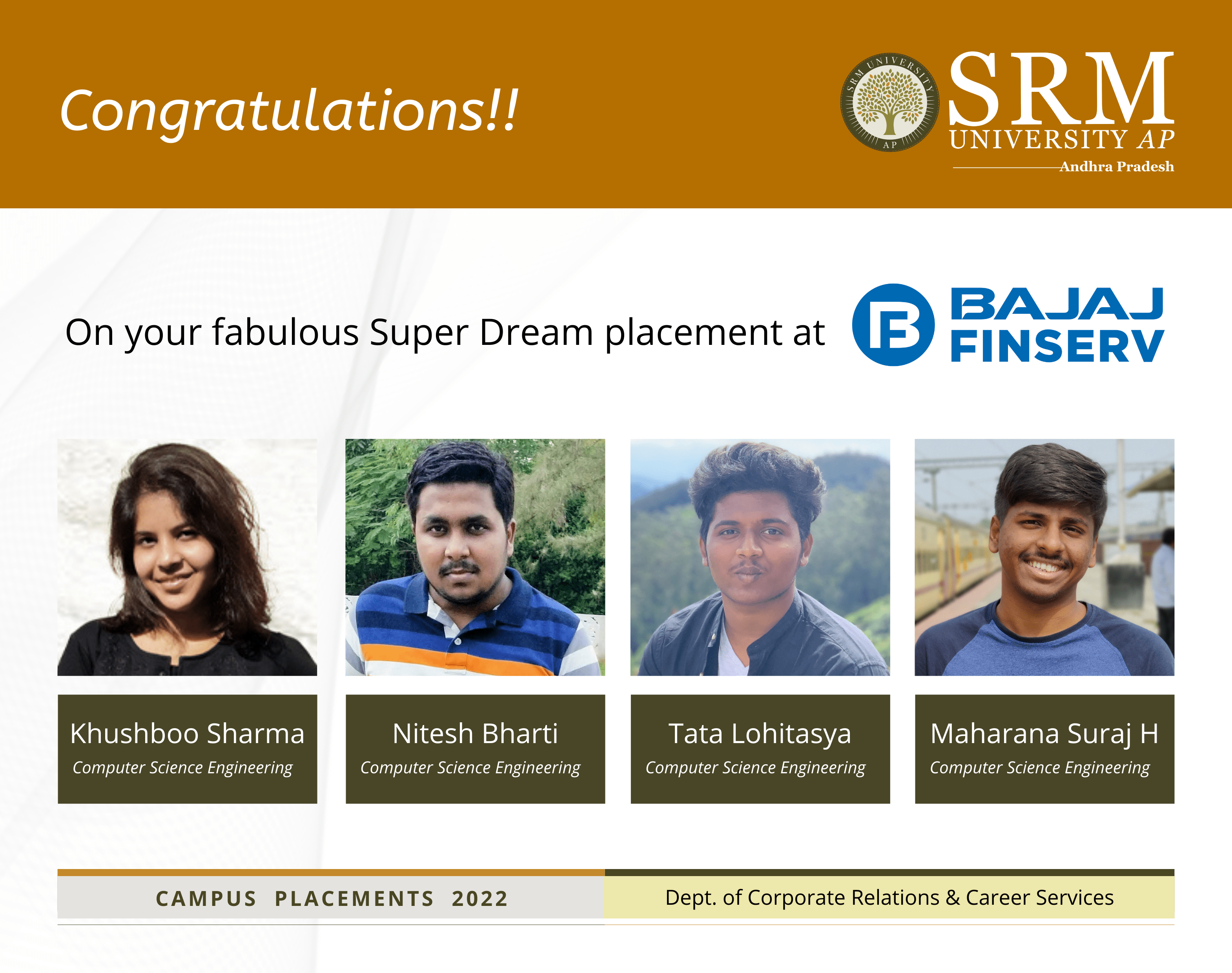 Maharana Suraj Harihar, Nitesh Bharti, Tata Lohitasya, Khushboo Sharma are four undergraduates from the Department of Computer Science and Engineering who have got placed with the financial services company Bajaj Finserv Ltd. in the Engineering Campus placements for the class of 2022. They will be working in the headquarters of the company in Pune.
Maharana Suraj Harihar, Nitesh Bharti, Tata Lohitasya, Khushboo Sharma are four undergraduates from the Department of Computer Science and Engineering who have got placed with the financial services company Bajaj Finserv Ltd. in the Engineering Campus placements for the class of 2022. They will be working in the headquarters of the company in Pune.
Bajaj Finserv Limited is a part of Bajaj Holdings & Investments Limited, a leading financial services company focused on wealth management, insurance, lending, and asset management. Being India’s fastest-growing and most diversified non-banking financial corporation, the company gives opportunity to fresh graduates to build their careers.
The first shortlisting round was Application Programming Interfaces (API) test and it was followed by the second round of coding with multiple-choice questions. The third round was the technical interview based on the projects that the students have done and their major achievements during the course. Questions related to data access and algorithm, technologies like eCommerce development and blockchain were also asked.
Nitesh Bharti, one of the placed students, says that he was rejected in so many interviews and couldn’t even clear the coding tests many times. “My persistent efforts with the support of the CR&CS department have finally paid off well. The mock interviews, industry readiness webinars, practical sessions to polish coding skills have been really helpful. Dr Ajay, Dr Manikandan and Dr Priyanka from the CSE department are my mentors and I cannot overlook their guidance and support”, said the overjoyed Nitesh. “The projects that I did as part of studies – One related to Covid-19 analysis and one DBMS project related to the e-voting system- helped me a lot in cracking the interview. My advice to juniors who are to attend placement interviews is that never lose hope”, he added.
Tata Lohitasya, another student thanks to the support of the placement team that has been very resourceful and the separate orientation sessions conducted for different companies. “Subjects like ISCP and training by CCC have been very helpful. The CR&CS department has been very approachable throughout the process”, said Tata. “The SRM AP faculty have helped me to create a strong base on conceptual topics. Dr Murali Krishna, Dr Ashok Kumar, and Dr Amit Kr Mandal from the department of CSE are my mentors”, he added.
- Published in CR&CS, CR&CS NEWS, CSE NEWS, News, Students Achievements
Sai Harshini from the class of 2022 gets placed at AB InBev
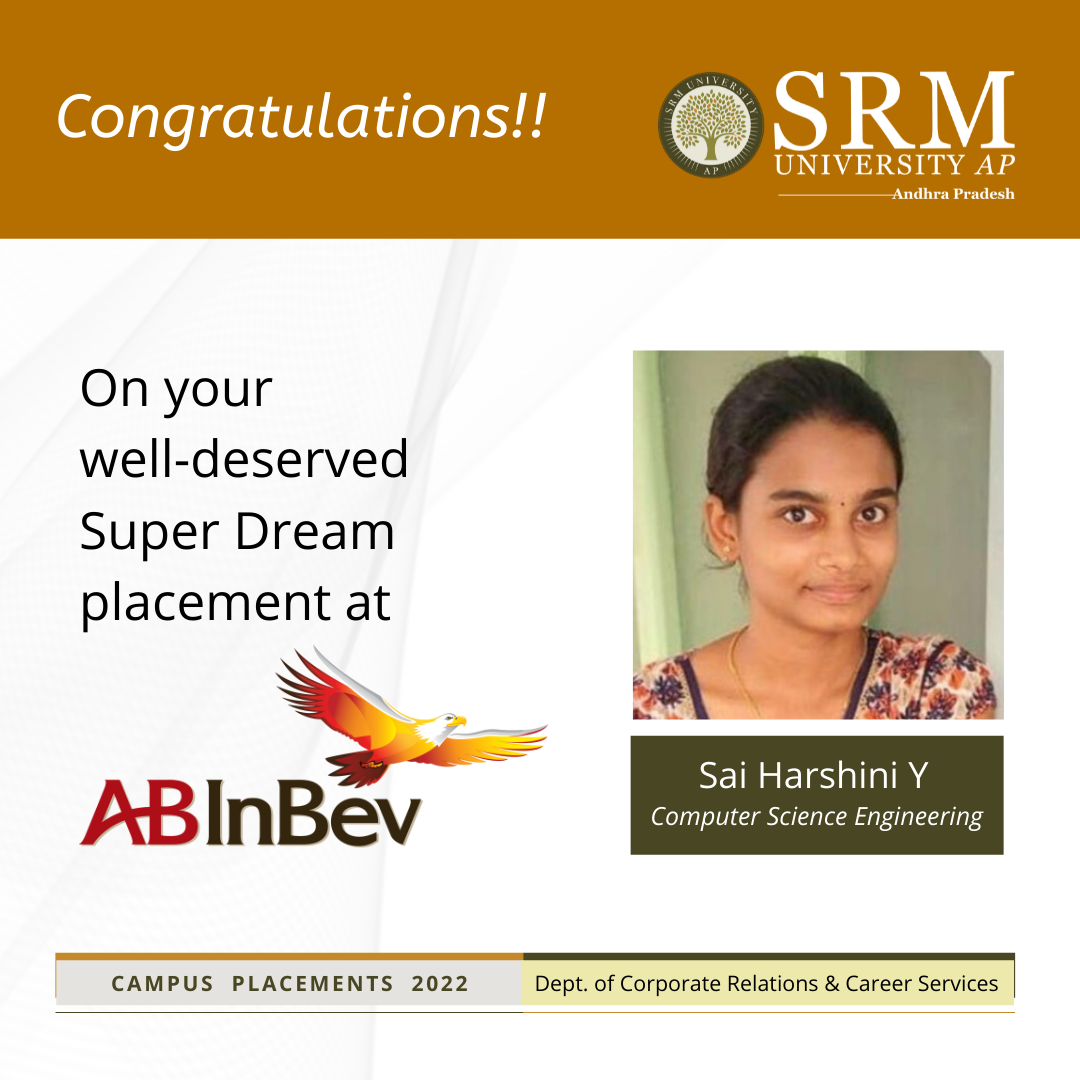 Yadlapalli Sai Harshini, a student from the Department of Computer Science & Engineering has received a mesmerizing job offer from the world’s largest brewing company, AB InBev, in the Engineering Campus Placement for the class of 2022. She will soon start working at the Global Capability Centre located in Bangalore with a CTC of 12LPA.
Yadlapalli Sai Harshini, a student from the Department of Computer Science & Engineering has received a mesmerizing job offer from the world’s largest brewing company, AB InBev, in the Engineering Campus Placement for the class of 2022. She will soon start working at the Global Capability Centre located in Bangalore with a CTC of 12LPA.
The first shortlisting round was an online test with multiple-choice questions on aptitude, domain knowledge, and coding; followed by a group discussion. The third round was a technical interview based on the resume, followed by an HR interview.
In the words of Sai Harshini:
I am so happy to receive the offer from the world’s largest beverage and brewing company, AB InBev. The inclusion of Industry Standard Coding Skills & Industry Standard Employability Skills courses in the curriculum right from the first semester has helped me hone my coding and communication skills continuously. The projects I’ve done and my research publications with Dr Manikandan have made me stand out from the crowd. The extra-curricular activities at the university I’m part of, Student Council and Social Media Ambassadors, helped me understand perspectives, gain morale, exposure to working in a team and social skills.
The resources provided, sessions before the recruitment drive and the talks with our seniors organised by the CR & CS department helped me get an idea of how the process is going to be and what I need to be prepared for. Thanks to the CR&CS department, the CCC team, and all my mentors. My advice to my peers and juniors is to not worry about what you don’t have, instead be confident and ready to justify what you have. That’s what I’ve done.
The Department of Corporate Relations & Career Services (CR&CS) at SRM University-AP interacts closely with the industry to make the university a favoured destination for national and international organisations looking to recruit fresh talent. The CR&CS Department, SRM University-AP, considers the placement process very crucial and extends every kind of support to ensure that the students are given the best opportunities to streamline their career interests.
- Published in CR&CS, CR&CS NEWS, CSE NEWS, News, Students Achievements
K Jeevan Sai from CSE lands in NielsenIQ with 11.79 LPA
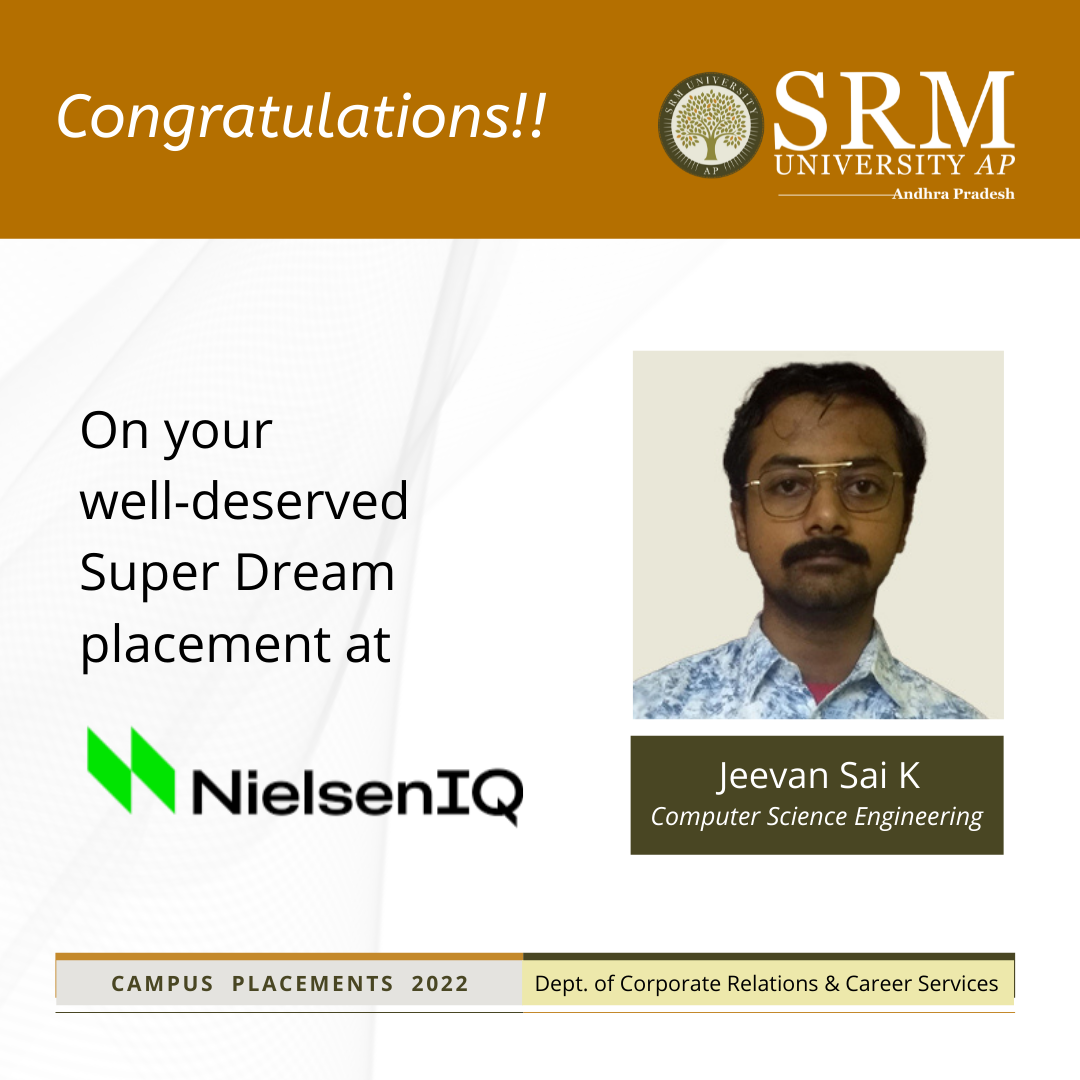 Kanaparthi Jeevan Sai, a B Tech final year student from the Department of Computer Science & Engineering, has secured an exciting job offer with an annual salary package of 11.79 lakhs from NielsenIQ, an industry leader in data points, detailed intelligence, and solutions. He will join the organisation as a full-time Java Software Engineer and work from the Chennai location.
Kanaparthi Jeevan Sai, a B Tech final year student from the Department of Computer Science & Engineering, has secured an exciting job offer with an annual salary package of 11.79 lakhs from NielsenIQ, an industry leader in data points, detailed intelligence, and solutions. He will join the organisation as a full-time Java Software Engineer and work from the Chennai location.
NielsenIQ Consumer LLC is a dream destination for students who specialize in core areas of engineering. For the first three years, the university provided the students with the basics of programming, technical languages, data structures and algorithms. And later in the final year, the placement cell designed student-specific intensive training for all students aspiring for high-paying jobs. The training also covered all the possible model questions for coding rounds and discussed the pattern of previous years.
Jeevan Sai says that the projects need to be presented according to the company and it is important that the resume is well-written and simple. “Group discussions and some of the sessions which helped us to improve our personal and interview abilities and public speaking were arranged by the Department of CR&CS in association with Barclays (also a company). These and were led by industry experts. I thank the placement department for being very active throughout the placement season and clearing our doubts effectively, “Jeevan Sai stated.
- Published in CR&CS, CR&CS NEWS, CSE NEWS, Departmental News, News, Students Achievements
Final year students get placed in ZS Associates
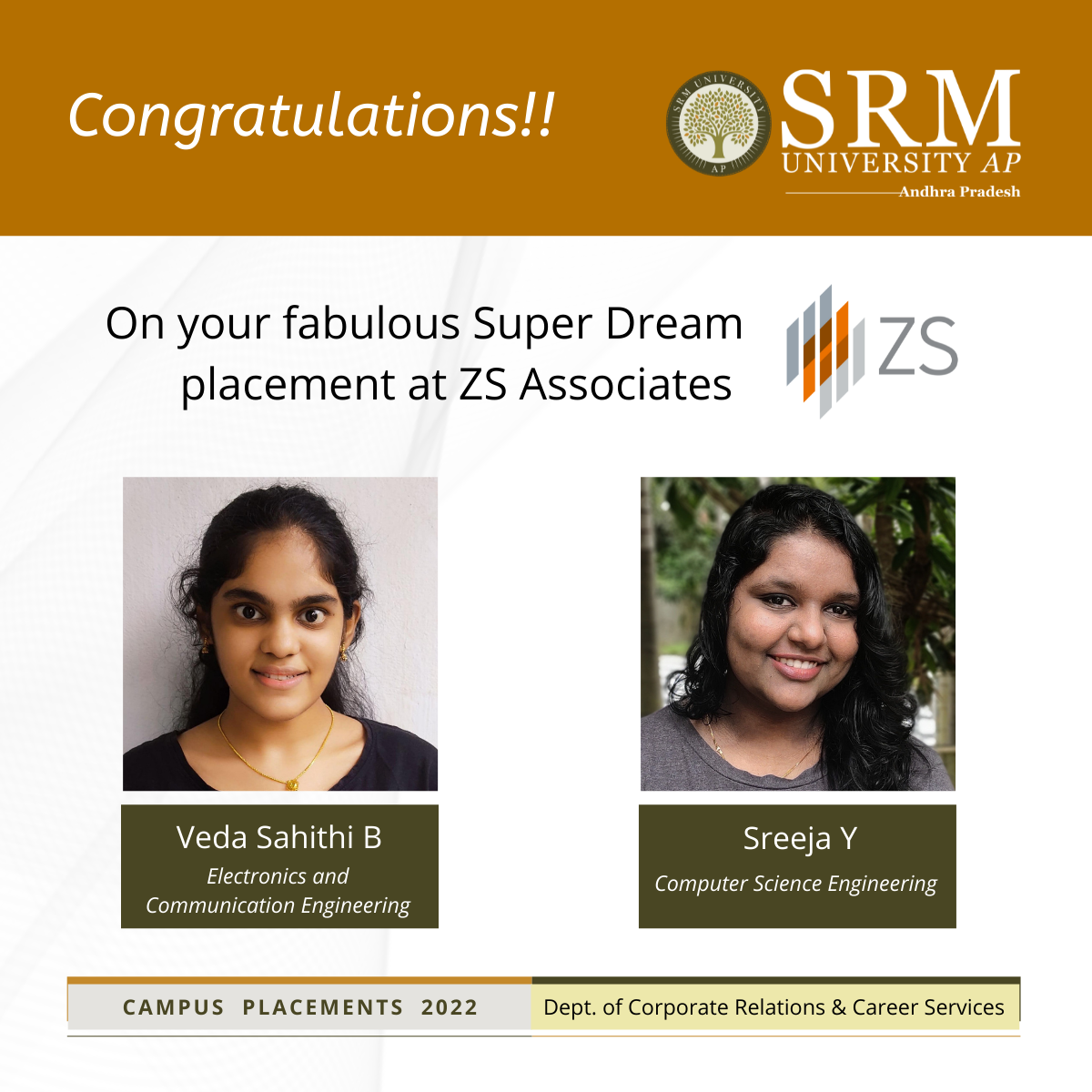 Bandi Veda Sahithi from the Department of Electronics and Communication Engineering, and Sreeja Y from the Department of Computer Science Engineering have been placed at ZS Associates with an exciting CTC of 14.35 LPA.
Bandi Veda Sahithi from the Department of Electronics and Communication Engineering, and Sreeja Y from the Department of Computer Science Engineering have been placed at ZS Associates with an exciting CTC of 14.35 LPA.
Students started their preparation two months prior to the month of placements (approximately April-May and placements started in July). Following a disciplined timetable, and the CCC training given by the university, students have achieved their dream job offers! As Sreeja Y is a Computer Science Engineering Student, she mainly focused on DSA, DBMS, OOPs, OS and Aptitude (sources she used to prepare are Geekofgeeks, YouTube, Hackerrank, Leetcode for coding, W3schools).
The Curriculum for placement provides intensive training for 1 and a half month where the students receive CCC training, Domain training (TIME), and Aptitude training. The CCC Classes helped students understand DSA concepts and apply those concepts in coding. In the Domain training students were taught DSA, CN, OOPs, OS and it helped them further in SQL, DBMS concepts.
Sreeja expresses her gratitude for the guidance, training and sources of knowledge she received from SRM University-AP. “Approximately 75 companies lined up for recruitment in a month. Placement Cell really gives us great and wide opportunities to achieve our goals.” “The placement cell is a wonderful interactive platform that connects various companies with the university, providing abundant opportunities”, added Veda Sahithi.
- Published in CSE NEWS, Departmental News, ECE NEWS, News, Students Achievements
CSE students to transform the future through Accolite Digital
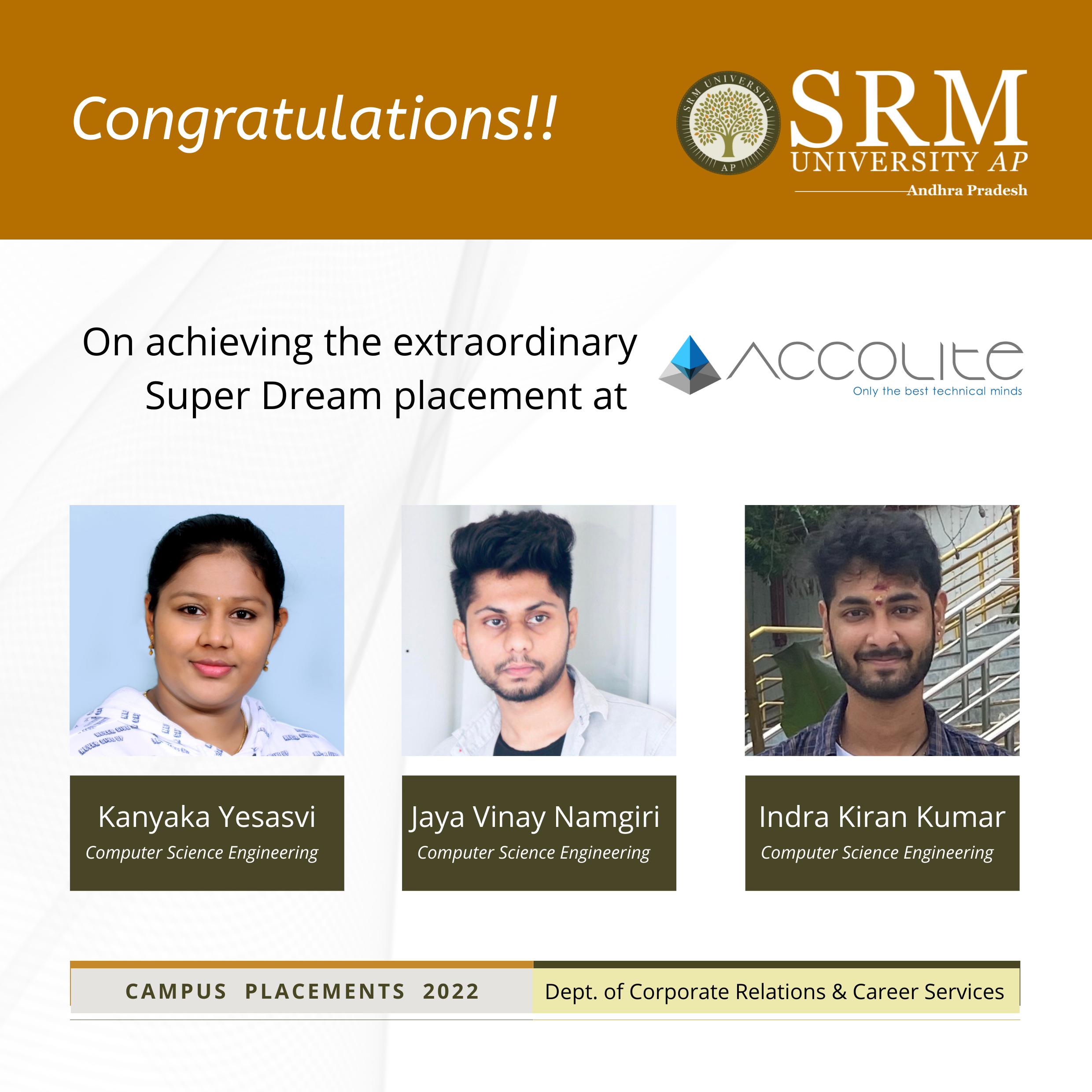 Kanyaka Yesasvi, Jaya Vinay Namgiri, Payeli Indra Kiran Kumar, three vibrant students from the Department of Computer Science Engineering get placed in the reputed digital and product engineering services and solutions company Accolite Digital with an exciting CTC of 11LPA.
Kanyaka Yesasvi, Jaya Vinay Namgiri, Payeli Indra Kiran Kumar, three vibrant students from the Department of Computer Science Engineering get placed in the reputed digital and product engineering services and solutions company Accolite Digital with an exciting CTC of 11LPA.
Accolite Digital, founded in 2007, is a cutting-edge, best-in-class digital transformation services company that has successfully delivered design-driven challenging digital transformation efforts to Fortune 500 companies. They accomplish so by using a network of talented and passionate technologists to simplify their clients’ digital journeys through human-centric design and product innovation Accolite Digital is able to generate compelling business outcomes and when applied to any organisation, this encourages cross-team collaboration to drive transformed digital experiences. Their agile product innovation strategy speeds up design and development while offering a high return on investment.
The curriculum of SRM university-AP consists of training for placements beginning from the second year of graduate studies. It helps students to plan for the recruitment drive beforehand. The curriculum of placement consists of CCC training where students are divided into batches given individual attention on respective domains.
Let’s look into what our students say:
Kanyaka Yesasvi:
When I got to know that I received an offer in Accolite Digital as a software engineer I was overwhelmed with happiness. From July till date more than 80 companies visited us. Every day we are applying to multiple organisations through our placement cell. I am grateful to SRM University for giving me extraordinary opportunities to launch my career.
Payeli Indra Kiran Kumar:
The CR&CS department gives training on all important aspects required for us to crack the placement, like coding classes, contests, mock interviews, mock GD etc. I started preparing for the interviews using the materials provided by CCC. The faculty in my CSE department helped in all possible ways that they can. I suggest to juniors to make use of all the opportunities provided by the university and learn core subjects like DSA, OS, DBMS and CN for cracking super dream placement offers.
Jaya Vinay Namgiri:
Acceleration bootcamp provided by CCC helped me brush up on my coding skills and made me ready to face the companies in the Placement drive 2022. I thank the placement team for providing a helpdesk virtually in spite of this covid situation. That cleared all my doubts and helped me to plan accordingly. I would like to suggest my juniors develop any one project of their interest every year so that at the end of the third year they will be ready to face the recruitment drive.
- Published in CSE NEWS, Departmental News, News, Students Achievements
Resource and network-aware data placement algorithm for periodic workloads in cloud
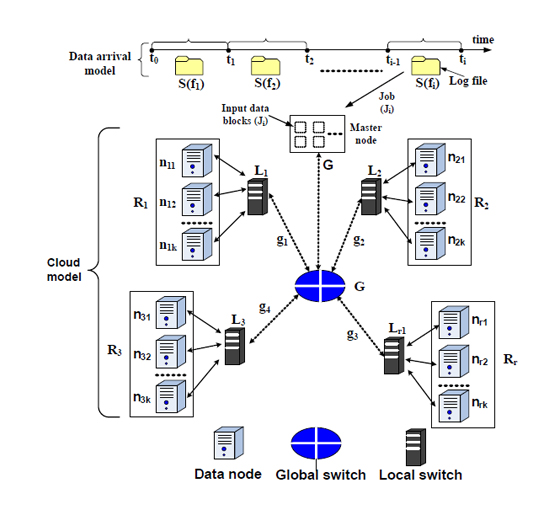 Dr Hirenkumar Thakkar from the Department of Computer Science and Engineering has published a research paper titled “RENDA: Resource and Network-aware Data Placement Algorithm for Periodic Workloads in Cloud” in the journal IEEE Transactions on Parallel and Distributed Systems Vol. 32, No. 12, pp. 2906-2920.
Dr Hirenkumar Thakkar from the Department of Computer Science and Engineering has published a research paper titled “RENDA: Resource and Network-aware Data Placement Algorithm for Periodic Workloads in Cloud” in the journal IEEE Transactions on Parallel and Distributed Systems Vol. 32, No. 12, pp. 2906-2920.
Each year, tech giants are spending millions of dollars to purchase the resources to store the data. However, efficient data placement is a critical issue for companies that experience several terabytes of data generation on daily basis. With such speed of data generation, it is the need of the hour to come up with a strategy for an efficient storage mechanism. This research investigates the data placement problems in cloud data centres and assists several tech giants such as Google, Facebook etc., to manage the cloud resource properly.
This research benefits society with a lower cost of cloud subscriptions, as tech giants are able to save several thousands of dollars by means of an efficient storage mechanism. This ultimately enables the tech giants to offer cloud service subscriptions at a reasonable cost.
The study was carried out in collaborations with Artificial Intelligence and Big Data Computing Lab (ABC Lab), Chang Gung University, Taiwan with Prof. Prasan Kumar Sahoo and in collaboration with Prof. Bharadwaj Veeravalli from the National University of Singapore. In addition to the current collaboration, there are several collaborations with the Indian Institute of Technology (IIT-BHU) as well as the University of Tartu, Estonia.
In future, Dr Thakkar is planning to come up with a book on cloud resource management using Nature-inspired learning. In addition to that, there are few projects such as filing two separate patents on Healthcare data analysis and opinion feature mining in collaboration with Chang Gung University, Taiwan, the National University of Singapore, and the University of Tartu, Estonia.
Read the full paper here: https://doi.org/10.1109/TPDS.2021.3080582
- Published in CSE NEWS, Departmental News, News, Research News
Dr Varaprasad Reddy joins orientation programme to motivate students
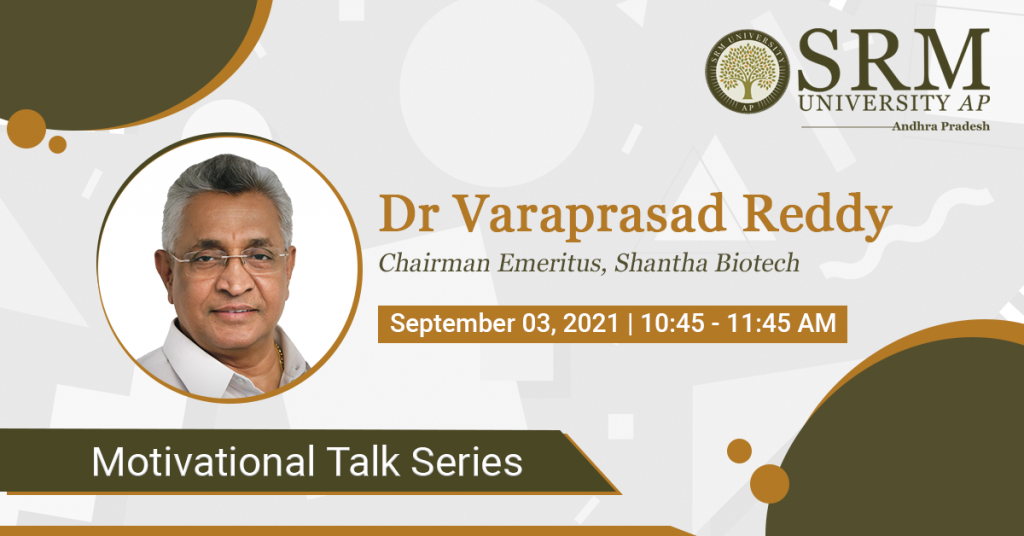 In the next chapter of the Freshmen Orientation Programme-2021, PADMA BHUSHAN Dr Varaprasad Reddy – Founder & Chairman of Shantha Biotechnics Ltd. will be joining us on September 03, 2021, at 10.45 am to meet and greet the new students.
In the next chapter of the Freshmen Orientation Programme-2021, PADMA BHUSHAN Dr Varaprasad Reddy – Founder & Chairman of Shantha Biotechnics Ltd. will be joining us on September 03, 2021, at 10.45 am to meet and greet the new students.
Dr Varaprasad Reddy is a versatile personality who has excelled in various domains of science and technology, entrepreneurship, and industrial development. He is the founder of Shantha Biotechnics, a company that purposes to produce cost-efficient vaccines for the dwellers of India. Shantha Biotechnics developed India’s first ‘indigenously developed’ vaccine against Hepatitis-B, which was made available in the market at a much-reduced cost compared to the imported alternatives.
The credit is due to Dr Varaprasad Reddy and his vision for enabling India to become the leading manufacturer of vaccines. His fervour to contribute to the country won him several accolades, such as the coveted PADMA BHUSHAN award from the government of India and honorary ‘doctorate’ from various universities of repute. The Freshmen 2021 are encouraged to avail the opportunity of attending the session with the illustrious Dr Varaprasad Reddy on September 03, 2021, at 10.45 am, who would propel you towards brilliance and compassion.
- Published in CSE NEWS, Events, Students Affairs Events
$1750 cash prize awarded to Team Hexagon at the International Hackathon 2021
Yuvraj Tankala and Joseph K Paul from the Department of Computer Science and Engineering, SRM University-AP has successfully bagged a cash prize of $1750 at the Datastax Hackathon held from Dec 2020 to Feb 2021. The duo formed the “Team Hexagon” and demonstrated their full-stack AI monitored online classroom and examination portal project at the international competition conducted by Datastax. It powered the innovative data apps to the Home Depot, T-Mobile, Intuit, and half of the Fortune 100 companies.
Rakuten India Enterprise Private Limited conducted this 24-hour challenge competition amongst 7000+ participants. Based on three rounds- 1) Ideation Phase 2) Build Phase 3) Finals-winners were decided. Each team comprised of one to four members and they were allotted various themes such as Mobile and Web Development, Web Analytics, Platform Development and Backend Engineering, Data Science, Machine Learning and Artificial Intelligence.
While briefing on the project, Team Hexagon elucidated, “We were excited to participate in the competition and immediately started working on the project. After outlining the base of the project, we were assured that it could create a positive impact during this unprecedented time of Covid-19 outbreak. The education system is facing tough times while managing online assessments. We introduced an AI model-based monitoring system for examiners and examinees involved in the evaluation process. The application follows the head and lip movements of the examinee by considering the various parameters. It tracks the head movement in two axes (up-down and right-left) and warns the examinee to concentrate on the screen. In a similar way, it follows the lip movement and alerts the examiner when found any abnormal movements in between assessment”.
Yuvraj and Joseph presented their project before Technology Business Incubator’s panel, which was shortlisted from 34 other proposals. Under this programme, they went under rigorous training for 12 months and received the felicitation of industry support, seed funding, innovation fund support, industry connectivity with the key players in the market. Winning over the competitive challenges has given the duo high confidence to work on multiple projects and plan to lead off a venture after the completion of academic years.
- Published in CSE NEWS, Departmental News, News
Image retrieval scheme with object detection and quantised colour histogram
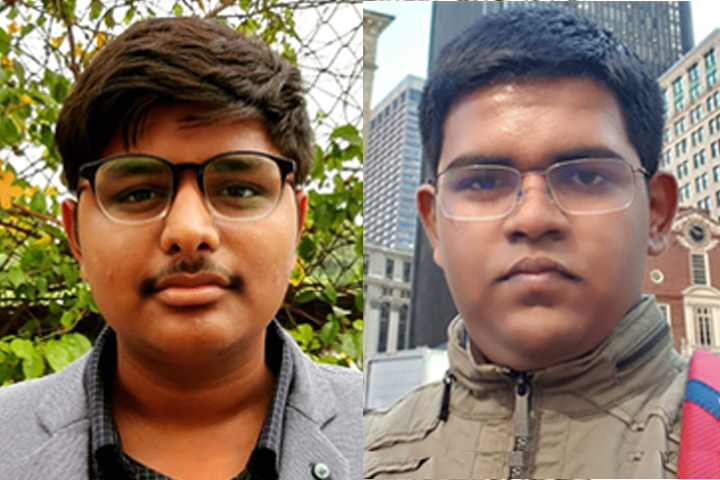 Yuvaraj Tankala and Joseph K Paul, 5th-semester B Tech Computer Science and Engineering students of SRM University-AP, Andhra Pradesh, India has worked with Dr Manikandan V M, Assistant Professor in Computer Science and Engineering Department on a research project and their research paper “A Content-based Image Retrieval Scheme with Object Detection and Quantized Color Histogram” got accepted for publication in the International Journal of Computational Science and Engineering.
Yuvaraj Tankala and Joseph K Paul, 5th-semester B Tech Computer Science and Engineering students of SRM University-AP, Andhra Pradesh, India has worked with Dr Manikandan V M, Assistant Professor in Computer Science and Engineering Department on a research project and their research paper “A Content-based Image Retrieval Scheme with Object Detection and Quantized Color Histogram” got accepted for publication in the International Journal of Computational Science and Engineering.
Content-based image retrieval (CBIR) is an active area of research due to its wide applications. Most of the existing CBIR schemes are concentrated to do the searching of the images based on the texture, colour, or shape features extracted from the query image. In this manuscript, we propose an object detection based CBIR scheme with quantized colour histograms. In the proposed scheme, the meaningful objects will be identified from the query image by using you only look once (YOLO) object detection techniques and the quantized histograms of each of the object categories. The object lists, their count, and the area covered by the objects along with quantized colour histograms will be used during feature matching to retrieve the related images from the large image pool. The experimental of the proposed scheme is carried on the Corel 1K and Caltech image dataset. We have observed an average precision of 0.96 during the experimental study which is quite high while comparing the precision from the well-known existing schemes.
To retrieve relevant images from a large image pool, we use content-based image retrieval (CBIR) schemes. In a CBIR scheme, the properties of the query image will be matched with the properties of the images in the image pool. The images which are very close to the given query image will be returned by the CBIR scheme. Most of the existing CBIR schemes use colour, shape and texture properties for image comparison. In the proposed scheme, we use an object detection-based approach with quantized colour histograms to retrieve the relevant images from the image pool.
The real-life applications of the proposed scheme are listed below:
● In the fashion designing and textile industry, CBIR systems can be used to find the existing designs.
● The CBIR systems are useful in crime prevention by retrieving similar crime scenes or the images of criminal persons based on the query image.
● Professional web designers or poster designers want to retrieve relevant images depends on the specific context that they are working.
● To retrieve similar medical images with the relevant treatment details in a computer-assisted diagnosis system.
The team currently continue their research work in the same domain to come up with a content-based image retrieval system that will return the relevant images by understanding the relationships among the objects in the image. The classes of the objects in the scene and their properties also will be considered along with the relationship between the objects in the scene.
- Published in CSE NEWS, Departmental News, News, Research News
Securing Online Payments made through Wearable Devices
Smart devices and Internet of Things (IoT) are growing in importance every day and so do our security concerns about using them for our financial transactions. As we carry the world with us through wearable technology, Dr Sriramulu Bojjagani, Assistant Professor, Department of Computer Science Engineering works towards making wearable devices more secure.
With a thriving interest in Cyber Security, Formal Verification Methods and Vulnerability Analysis and Penetration Testing, Dr Bojjagani has recently published his paper on “A Secure IoT-based Micro-payment Protocol for Wearable Devices” in Peer-to-Peer Networking and Applications (PPNA), Springer.DOI: 10.1007/s12083-021-01242-y
Abstract:
Wearable devices are one of the parts of the essential cost of goods sold (COGS) in the wheel of the Internet of things (IoT), contributing towards a potential impact in the finance and banking sectors. There is a need for lightweight cryptography mechanisms for IoT devices because these are resource constraints. This paper introduces a novel approach to an IoT-based micro-payment protocol in a wearable device’s environment. This payment model uses “elliptic curve integrated encryption scheme (ECIES)” for encryption and decryption of the communicating messages between various entities. The proposed protocol allows the customer to buy the goods using a wearable device and send the mobile application’s confidential payment information. The application creates a secure session between the customer, banks, and merchant. The static security analysis and informal security methods indicate that the proposed protocol is withstanding the various security vulnerabilities involved in mobile payments. For logical verification of the correctness of security properties using the formal way of “Burrows-Abadi-Needham (BAN)” logic confirms the proposed protocol’s accuracy. The practical simulation and validation using the Scyther and Tamarin tool ensure the absence of security attacks in our scheme. Finally, the performance analysis based on cryptography features and computational overhead of related approaches specify that the proposed micro-payment protocol for wearable devices is secure and efficient.
Architecture for wearable devices:
The architecture for wearable devices is shown in Fig. 1. It consists of six types of entities, such as Issuer bank (IB), acquirer bank (AB), payment gateway (PG), a certification authority (CA), mobile terminal, and wearable sensing devices. The person using various wearable devices such as a smartwatch, smart wristband, smart glass, etc. In the architecture, a wearable device is connected to the mobile terminal through NFC. An app is running on a mobile device. Wearable devices are resource constraints because they have limited computing capabilities regarding battery, display, storage, and processing compared to a mobile terminal (smartphone). Hence, NFC is used to pair the wearable device and mobile terminal for transmitting public messages. Before conducting any transaction with the merchant, the customer and merchant should register their mobile numbers with the bank.
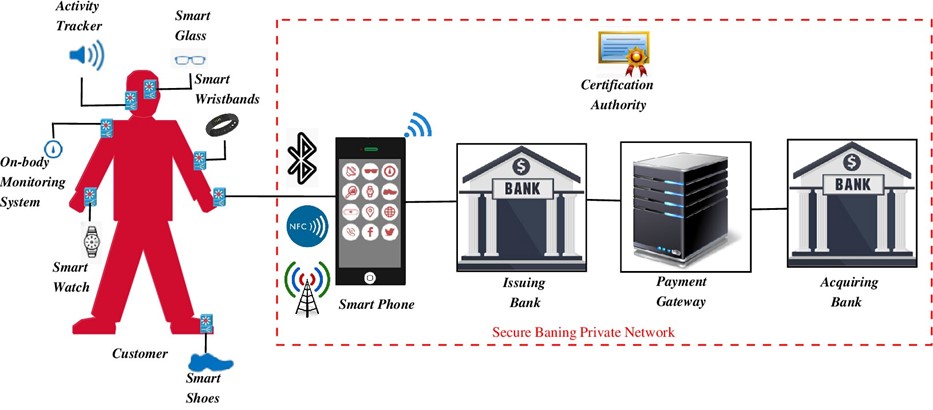
Fig. 1. Architecture for wearable devices
The customer can place an order with the merchant using the following steps and the complete messages flow in the proposed protocol is shown shown in the Figure.
● The customer places an order for an item through a wearable device.
● The request is transferred to the mobile app. The mobile app verifies the user authentication.
● After a successful authentication request, the app forwarded the request to the issuing bank for payment verification.
● The customer also sends a payment request for a deduction of the amount from his/her issuing bank.
● Once the bank validates the customer data in terms of sufficient funds available and user’s integrity. The issuing bank routes the transaction to the payment gateway through a secure network.
● In this step, the payment gateway verified the customer payment order and transferred it to the acquiring bank.
● If all the verifications are successful, then the transaction amount is then debited from the issuing bank and credited to the merchants’ acquiring bank.

Application demonstration:
As we know, most wearable devices run the Android operating system. The proposed framework developed as an Android application package (APK) file run in an Android wearable emulator, but we have operated in the Samsung Galaxy Note-2 device due to limits of the screen device and lack of environment. First, it needs to install the APK file and start running the app. Before running the app, some points need to be considered, such as the following:
● The company voice gateway provided for the service of an SMS gateway connected to Xeon server and assigned us a shortcode 56677.
● The payment gateway switch is used to communicate with the customer and merchant bank accounts.
● Two mobile numbers are registered with the banks and telecom operations, and it is used for SMS service.
● The deployed decryption web application on the Xeon server.
● HTTPS connection is used between voice gateway and Xeon server established Indian financial network (INFINET) link between server and bank.
We have not mentioned all the screenshots for the app from starting the login and authentication phase, but the protocol requires the essential information only shown in the screenshot. We didn’t mention the banks considered for implementing the micro-payment protocol for security and reputation reasons.
The proposed protocol action is as follows:
Step 1: The customer x runs a wearable application to enter Wearable-id, mobile number, pin and amount and sends an encrypted message to the Xeon server via short-code 56677. To encrypt the message, the customer may choose any one of the ECC curves as shown in Fig. 2.
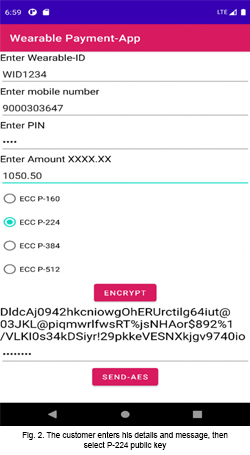
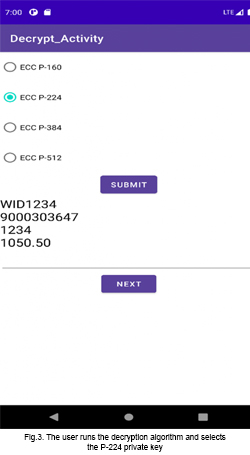
Step 2: The SMS gateway receives the encrypted SMS, which is delivered to the server
Step 3: The server receives the encrypted SMS and executes the decryption application. Next, the user runs decryption activity and selects the P-224 private key. After decryption, the message is shown in Fig. 3.
Step 4: After the message is decrypted, the user presses the “Next” button to communicate with the payment gateway.
Step 5: Now, the merchant fills in the remaining fields of merchant UPI-id, mobile number, and purpose of payment and then selects any payment gateway as shown in Fig. 4.
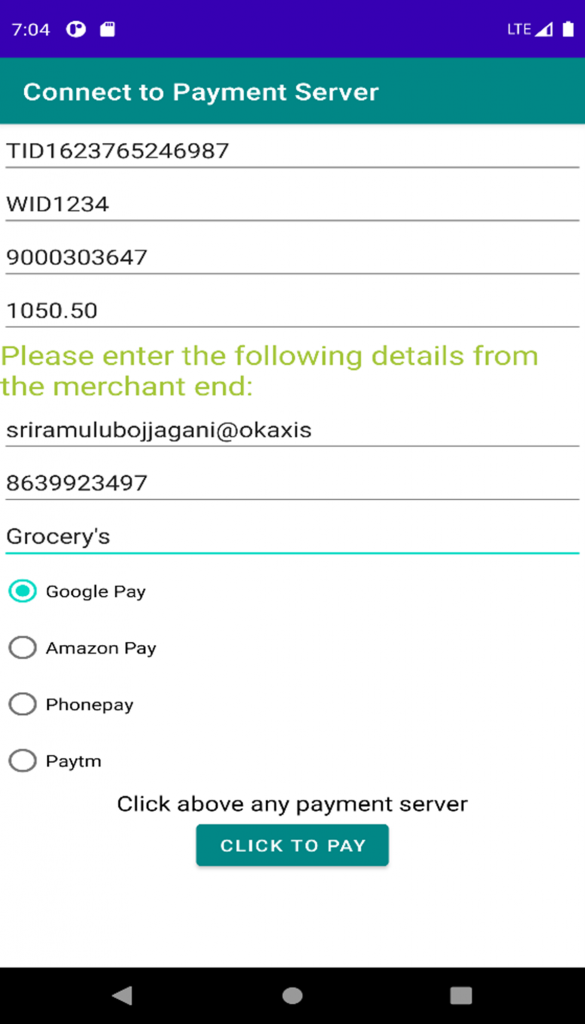
Fig. 4: The merchant enters the details and sends to any payment server
Dr Bojjagani’s research will further refine the parameters of security in IoT enabling wearable devices to become smarter and safer.
- To make the proposed protocols more secure can add biometric-based authentication can be added.
- The future directions of the proposed framework fit only for micro-payments. In future, we have upgraded to credit card/debit card payments to enhance the proposed framework for macro-payments.
- Published in CSE NEWS, News, Research News

